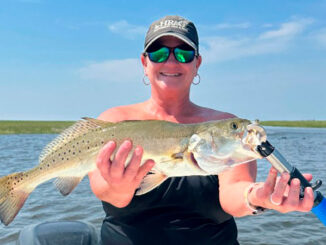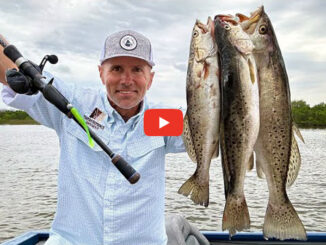
Members to consider specific changes in trout harvest regulations in future meetings
The Louisiana Wildlife and Fisheries Commission decided before its Sept. 5 meeting that it would not vote on adopting any changes in fishing regulations involving the official state saltwater fish — the speckled trout, but the commissioners heard plenty of options from biologists.
Near the end of a slide presentation, Jason Adriance, a fisheries biologist, pointed to a list of choices that may be considered when eventually settling on regulations to be implemented in 2020.
“These are a set of options which will be available to you,” Adriance said. “There can be creel-limit reductions, minimal-length limit increases, harvest slot-limit implementations, closed areas, closed seasons, special regulation implementation after severe winters . . . and we could have combinations of any of the above.”
Just what has happened to Louisiana’s speckled trout population to warrant the commission to consider these options?
Spawning stock biomass at lowest levels observed
 The spawning biomass refers to the female spawning stock in pounds of speckled trout that are capable of reproducing in Louisiana’s coastal waters. LDWF estimates that the number of reproducing trout has dropped from a high of 9.1 million pounds in 2008 to an average of 4 million pounds in 2018 — the lowest levels in 38 years.
The spawning biomass refers to the female spawning stock in pounds of speckled trout that are capable of reproducing in Louisiana’s coastal waters. LDWF estimates that the number of reproducing trout has dropped from a high of 9.1 million pounds in 2008 to an average of 4 million pounds in 2018 — the lowest levels in 38 years.
“You don’t want to be below (4.7 million pounds),” Adriance said. “(6.2 million pounds) is what we’re shooting for, the female spawning biomass has been below that target since 2014.”
Proportion of age 3+ females at lowest levels observed
 In addition, the proportion of female specks ages 3 and above is at its lowest levels since 1982. Thirty-seven years ago, the proportion of 3+ aged females was 24%. In 2018, it was approximately 5%.
In addition, the proportion of female specks ages 3 and above is at its lowest levels since 1982. Thirty-seven years ago, the proportion of 3+ aged females was 24%. In 2018, it was approximately 5%.
The proportion of older age classes of trout are very important to researchers as low percentages often signal high fishing mortality.
Recreational landings at lowest levels since 1990
 In 2011, recreational anglers caught approximately 8 million pounds of speckled trout. In 2018, the catch was estimated at 3 million pounds.
In 2011, recreational anglers caught approximately 8 million pounds of speckled trout. In 2018, the catch was estimated at 3 million pounds.
“Commercial landings are pretty much non-existent since the entanglement net ban in the mid-90s,” Adriance said.
 “One of the things that was part of the agreement with LA Creel (Louisiana’s Recreational Creel Survey) and increased license fees was that we would be able to get to Basin-level type data,” Adriance said. “This graphic shows you those recreational landings, but in the recent LA Creel years, we’ve broken that down by Basin.”
“One of the things that was part of the agreement with LA Creel (Louisiana’s Recreational Creel Survey) and increased license fees was that we would be able to get to Basin-level type data,” Adriance said. “This graphic shows you those recreational landings, but in the recent LA Creel years, we’ve broken that down by Basin.”
Over the past four years, recreational landings are somewhat higher in the Pontchartrain, Barataria and Terrebonne Basins compared to lower landings observed in the Calcasieu-Sabine and Vermilion-Teche Basins.
Unfortunately landings in all Basins fell sharply in 2018.
 During the period from 2014 through 2018, LA Creel data indicates that, statewide, about 16 % of trout landings come from charter fishermen.
During the period from 2014 through 2018, LA Creel data indicates that, statewide, about 16 % of trout landings come from charter fishermen.
Fishing effort continues to rise
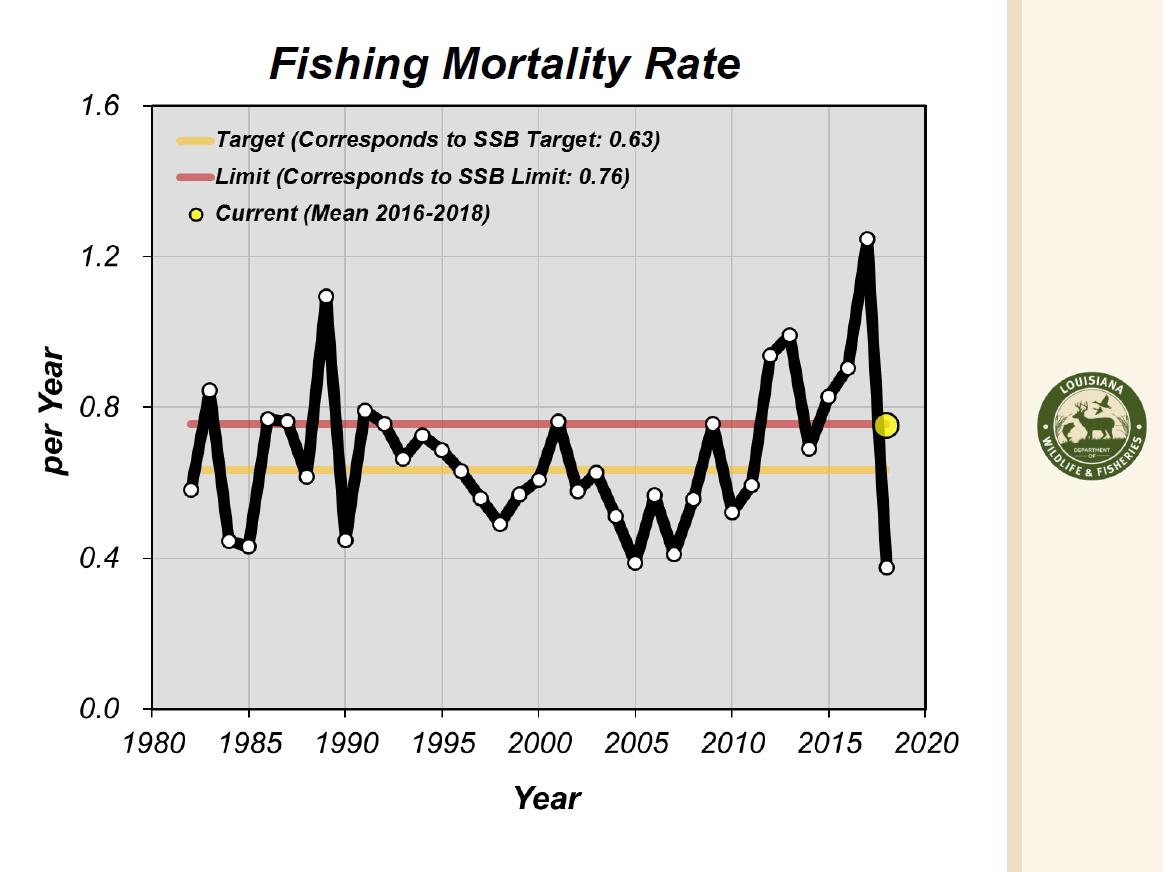 Data indicates that fishing mortality (has continued to rise over the years, despite the drop in recreational landings and spawning trout biomass.
Data indicates that fishing mortality (has continued to rise over the years, despite the drop in recreational landings and spawning trout biomass.
“You can see a wide swing in the last two years,” Adriance said. “Part of this relates to that winter kill we had (2017-18). We know we had a reduction in biomass after that winter kill. But the current mean (average) is still below that red line.”
The increase in fishing pressure and decline in recreational landings may be associated with anglers’ anecdotal reports of poor catches of speckled trout and fish of quality in the Lake Pontchartrain Basin, the Venice Delta area and the Calcasieu Basin. Such reports have increased over the past five years.
Overfished stock since 2014; and overfishing occurring 6 out of 10 most recent years
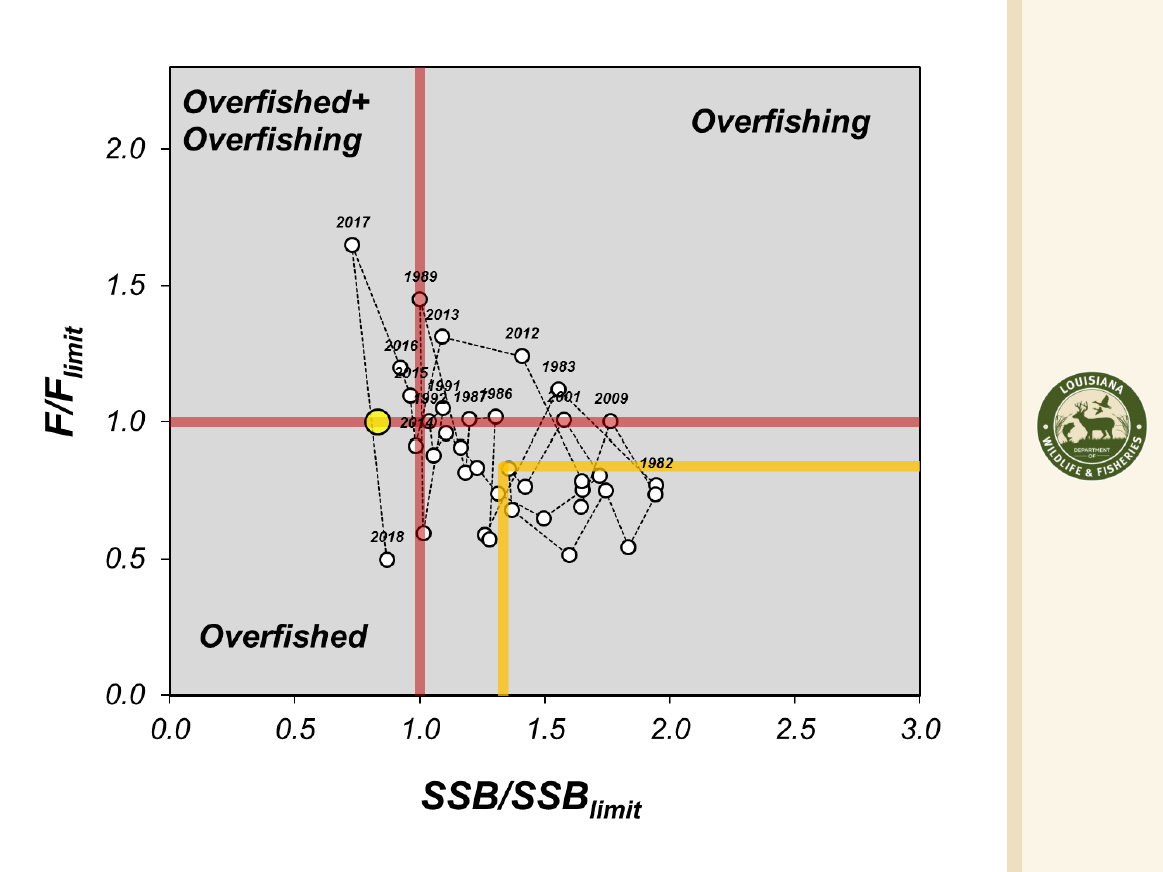 The slide above illustrates the interaction of spawning biomass and fishing mortality.
The slide above illustrates the interaction of spawning biomass and fishing mortality.
“Inside that yellow box is where we want to be,” Adriance said. “As you can see, we are in that overfished and overfishing quadrant, and this (slide) just tracks that through time.
 Adriance said speckled trout have been overfished since 2012, with the exception of 2014, and it’s been overfished since 2014. We’ve been overfishing in six out of the 10 most recent years.
Adriance said speckled trout have been overfished since 2012, with the exception of 2014, and it’s been overfished since 2014. We’ve been overfishing in six out of the 10 most recent years.
The problem with persistent overfishing is that speckled trout biomass could eventually fall and reduce numbers of young speckled trout entering into the adult fishery (recruitment).
The possibility of low recruitment due to overfishing can be significant especially if it occurs during winter-kill years (slide 8) leaving trout stocks weak and slow to rebound in following years.
Spawning Potential Ratio (SPR)
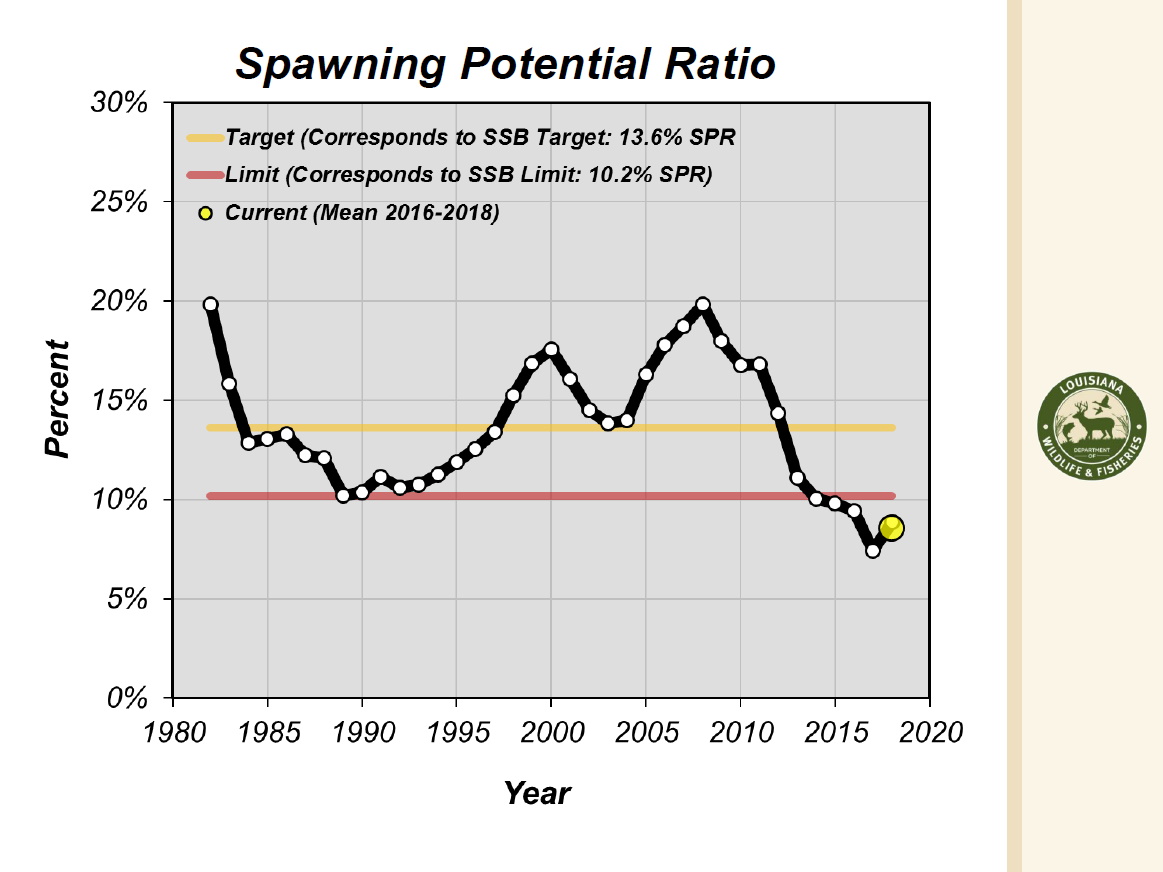 Spawning potential ratio is a percentage statistic representing an estimate of the stock’s potential to spawn with fishing pressure compared to spawning without fishing pressure.
Spawning potential ratio is a percentage statistic representing an estimate of the stock’s potential to spawn with fishing pressure compared to spawning without fishing pressure.
“We are below our limit there,” Adriance said. “In the last three years, we’re at 8.5%. Our limit is 10.2%, but we are shooting for 13.6.”
A conservation standard of 18% SPR has been set traditionally for Louisiana’s speckled trout after years of studying their populations. Louisiana is now aiming for an even lower % SPR by as much as 4.4%.
Other states manage trout populations at 10% to 15% above a higher conservation standard than Louisiana, thereby adding a margin of safety against significant increases in fishing pressure occurring at times of environmental stress on the habitat.
Next steps for the Commission
“We’re going to come back to the Commission with an analysis of potential management options to improve the status of the stock,” Adriance said. “We’re looking for (the Commission’s) feedback on some preferred management options. And, changes will need to be significant and likely controversial.”
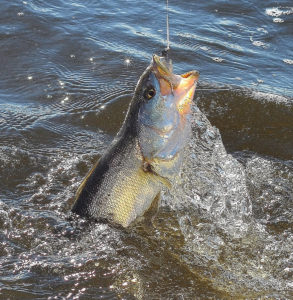
David Cresson, Louisiana Coastal Conservation Association (CCA) executive director, was among the 50 members of the public attending the meeting.
“I think we need the time to learn a lot more because everyone in the fishing community is concerned,” Cresson said. “We need to see more information before rushing into any judgements.”
According to Cresson, the 23,000 member Louisiana CCA has always led the way to positive fisheries management.
“When we fully understand the science regarding the variables at play, this will guide us going forward to the best possible management efforts in Louisiana,” he said.
According to Rene LeBreton, LDWF public information director, there were 50 attendees at the meeting, and 99 others viewed via the Go-to-Webinar online session.
No attendee offered any public comment at the meeting regarding the stock assessment agenda item.

